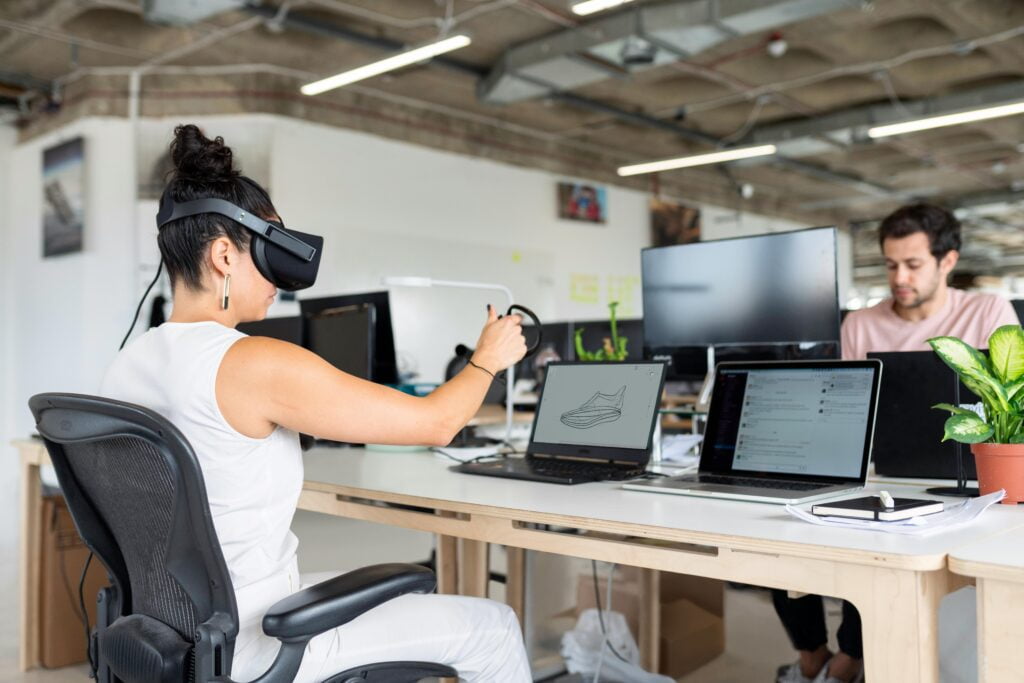
Businesses and developers can use virtual reality to build experiences that fulfill a variety of vital functions. Virtual reality (VR) has the potential to revitalize the tourism sector in the aftermath of the epidemic. Additionally, VR has the ability to provide individuals who require it most—such as surgeons and military personnel—with better, more meaningful training experiences.
Don’t worry if you’re a touch behind the virtual reality hype train. We are here to answer all of your questions about virtual reality and its capabilities.
What is the market for virtual reality?
Let’s define things first. In the context of XR, virtual reality, or VR, is a type of immersive technology that substitutes a virtual environment for the real one. You can interact with digital content in a virtual world using a VR headset and software, much like you would with actual objects in your living room or office.
Virtual reality is developing to be more than just a tool for amusement. Teams in the workplace can work together more effectively in virtual reality environments as face-to-face collaboration isn’t always possible. Virtual Reality facilitates unprecedented levels of creativity by enabling individuals to test various concepts and prototypes for goods without squandering tangible materials.
The capabilities of a VR headset are getting more and more amazing as technology advances; in certain situations, things like immersive haptic feedback and even cognitive control are now available. Nonetheless, the bulk of VR experiences on the market come with the following elements:
3D content: Real virtual reality experiences use 3D visuals and experiences to completely submerge you in the new scene, rather than just providing you with a picture to look at. The goal of 3D material is to truly transport the viewer to a different environment, like a meeting room. Some of it is more realistic than others.
Sensors and tracking: Depending on the application, a VR experience might provide you varying degrees of agency. While some solutions only let you navigate around an area, others let you engage with the environment. Your VR system needs sensors and tracking to detect your movements, whether you’re just strolling or picking things up.
The device mainly in charge of substituting your real world for a virtual one in a virtual reality system is the headset. Improved displays with integrated eye-tracking components show you an image as if you’re gazing around you. The efficiency and light weight of modern headsets are rising.
Where Was the Origin of Virtual Reality?
Contrary to popular belief, virtual reality has been around for far longer.
We’ve only recently started investigating VR as a potential replacement for traditional classroom instruction and a means of revolutionizing the workplace. But in the 1960s, the original head-mounted display made a reappearance under the moniker “HeadSight.” Prior to this, there existed analog counterparts of virtual reality (VR) that aimed to provide consumers with a more “immersive” experience.
Compared to the technologies we had in the past, the virtual reality we have now is far more astounding. The lightweight, efficient solutions of today can give people experiences that are more like the actual thing. To produce new cars, for example, Ford has its own VR design studio where individuals may collaborate.
Better tracking experiences and more robust software are made possible by VR’s growing alignment with other disruptive technologies, such as artificial intelligence.
The hardware and software components that make up today’s VR solutions combine to produce an immersive 3D environment with input tracking. Additionally, businesses have access to cutting-edge VR solutions with amazing HD images and full-body tracking.
The VR-compatible accessories are also getting better and better. Examples include haptic gloves that let you feel and touch the virtual objects you’re using, and eye-tracking devices that let you manipulate information with your mind.
What Advantages Does Virtual Reality Offer?
There are still difficulties with VR nowadays. Customers may not always find headsets to be as light as they would want, and prolonged use of these devices can cause VR sickness in many users. It can be very costly to invest in an immersive VR platform and headsets for every employee, which deters some businesses from participating.
Still, a lot of these problems have already begun to be resolved. Since the epidemic, more money has been invested in VR R&D, which has sped up the timeline to a time when everyone will have access to more effective and comfortable VR experiences. We’ll soon witness a virtual reality environment where people may work together and test ideas.
VR will be used by professionals in otherwise risky situations to develop muscle memory without endangering anyone. Virtual reality (VR) is already being used by universities and other educational institutions to teach nurses and other specialists how to carry out procedures.
Virtual reality has the potential to save businesses money and save the environment. There won’t be a need to travel to meet people globally when VR encounters can be more immersive. Virtual reality and mixed reality have the potential to virtually eradicate the requirement for business travel.
Virtual Reality’s Future Is Near
Businesses and entrepreneurs have been talking about the potential benefits of virtual reality (VR) and how it may help the globe for years. We’re starting to realize now how useful this technology truly is. VR has no bounds to where it could go as headsets get cheaper and more accessible creative technologies.







